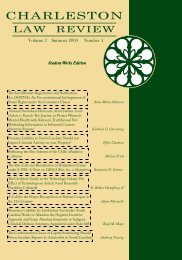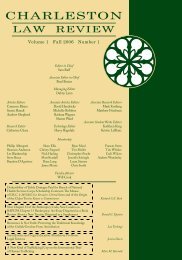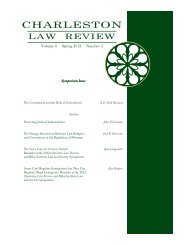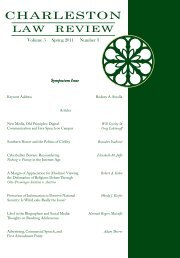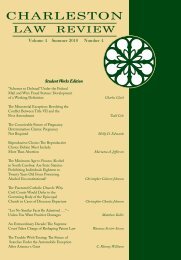Volume 5 Winter 2011 Number 2 - Charleston Law Review
Volume 5 Winter 2011 Number 2 - Charleston Law Review
Volume 5 Winter 2011 Number 2 - Charleston Law Review
You also want an ePaper? Increase the reach of your titles
YUMPU automatically turns print PDFs into web optimized ePapers that Google loves.
SCHULZE FINAL.doc1/20/<strong>2011</strong> 6:14PM<strong>2011</strong>] <strong>Law</strong> School Academic Supportnegative impact that law school has on many students.A. A Brief History of the Humanizing MovementThe humanizing legal education movement likely had itsgenesis in 1986 when Andrew Benjamin first documented therole of legal education in psychologically harming its students. 59Legal scholars then began examining not only whether lawschool tended to cause distress in students, but also the causes ofthat distress. These efforts included notable articles byProfessors Barbara Glesner Fines and <strong>Law</strong>rence Krieger. 60Momentum began to build, which culminated in severalgalvanizing events. First, the AALS created a section called“Balance in Legal Education.” 61 Second, the section initiated aListserv designed to expand communication about humanenessbetween like-minded educators. 62 Finally, in 2007, WashburnUniversity School of <strong>Law</strong> held a symposium focusing onhumanizing legal education. 63 Instead of a few isolated scholarsfocusing on this subject, now large groups of legal educatorscutting across all genres of the law work together to move toward59. See Schwartz, Humanizing Legal Education, supra note 37, at 235(citing G. Andrew H. Benjamin et al., The Role of Legal Education in ProducingPsychological Distress Among <strong>Law</strong> Students and <strong>Law</strong>yers, 1986 AM. B.FOUND.RES.J. 225). The Benjamin study empirically demonstrated the psychologicallyharmful effects of law school. The psychopathological symptom responses ofstudents prior to law school were similar to the normal population. During lawschool and after graduation, however, symptom levels elevated significantly.60. See B.A. Glesner, Fear and Loathing in the <strong>Law</strong> Schools, 23 CONN. L.REV. 627, 630 (1991) (noting that the “extreme pressure of legal educationinterferes with learning, teaches inappropriate interpersonal skills, andencourages counterproductive behaviors and attitudes among students”);<strong>Law</strong>rence S. Krieger, Institutional Denial About the Dark Side of <strong>Law</strong> School,and Fresh Empirical Guidance for Constructively Breaking the Silence, 52 J.LEGAL EDUC. 112, 112–13 (2002) (noting faculty denial of law studentdepression and suggesting “individual and collective faculty approaches” toremedy the situation).61. Bruce J. Winick, Greetings from the Chair, EQUIPOISE (Ass’n of Am.<strong>Law</strong> Sch. Section on Balance in Legal Educ.), Dec. 2009, at 1, available athttp://www.aals.org/documents/sections/balance/BalanceInLegalEdDec_09.pdf.62. Humanizing Ideas, FLA. ST. U., http://humanizingideas.law.fsu.edu/default.asp (last visited Dec. 13, 2010).63. See Schwartz, Humanizing Legal Education, supra note 37, at 236.289



